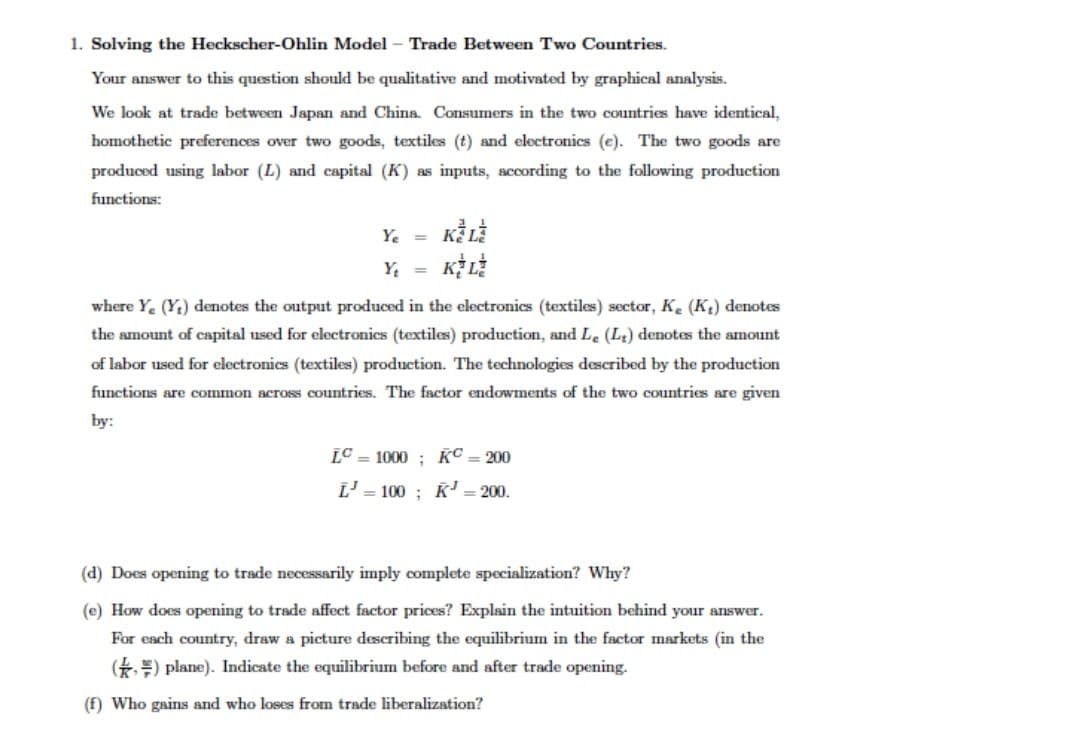1. Solving the Heckscher-Ohlin Model - Trade Between Two Countries. Your answer to this question should be qualitative and motivated by graphical analysis. We look at trade between Japan and China Consumers in the two countries have identical, homothetic preferences over two goods, textiles (t) and electronics (e). The two goods are produced using labor (L) and capital (K) as inputs, according to the following production functions: Y. = Y, = where Y. (Y;) denotes the output produced in the electronics (textiles) sector, K. (K;) denotes the amount of capital used for electronics (textiles) production, and Le (Lt) denotes the amount of labor used for electronics (textiles) production. The technologies described by the production functions are common across countries. The factor endowments of the two countries are given by: LC = 1000 ; K© = 200 L' = 100 ; K' = 200. (d) Does opening to trade necessarily imply complete specialization? Why? (e) How does opening to trade affect factor prices? Explain the intuition behind your answer. For each country, draw a picture describing the equilibrium in the factor markets (in the (*) plane). Indicate the equilibrium before and after trade opening. (f) Who gains and who loses from trade liberalization?
1. Solving the Heckscher-Ohlin Model - Trade Between Two Countries. Your answer to this question should be qualitative and motivated by graphical analysis. We look at trade between Japan and China Consumers in the two countries have identical, homothetic preferences over two goods, textiles (t) and electronics (e). The two goods are produced using labor (L) and capital (K) as inputs, according to the following production functions: Y. = Y, = where Y. (Y;) denotes the output produced in the electronics (textiles) sector, K. (K;) denotes the amount of capital used for electronics (textiles) production, and Le (Lt) denotes the amount of labor used for electronics (textiles) production. The technologies described by the production functions are common across countries. The factor endowments of the two countries are given by: LC = 1000 ; K© = 200 L' = 100 ; K' = 200. (d) Does opening to trade necessarily imply complete specialization? Why? (e) How does opening to trade affect factor prices? Explain the intuition behind your answer. For each country, draw a picture describing the equilibrium in the factor markets (in the (*) plane). Indicate the equilibrium before and after trade opening. (f) Who gains and who loses from trade liberalization?
Chapter13: General Equilibrium And Welfare
Section: Chapter Questions
Problem 13.6P
Related questions
Question
Please solve it fast i will give double upvotes

Transcribed Image Text:1. Solving the Heckscher-Ohlin Model - Trade Between Two Countries.
Your answer to this question should be qualitative and motivated by graphical analysis.
We look at trade between Japan and China Consumers in the two countries have identical,
homothetic preferences over two goods, textiles (t) and electronics (e). The two goods are
produced using labor (L) and capital (K) as inputs, according to the following production
functions:
Y. =
Y, =
where Y. (Y;) denotes the output produced in the electronics (textiles) sector, K. (K;) denotes
the amount of capital used for electronics (textiles) production, and Le (Lt) denotes the amount
of labor used for electronics (textiles) production. The technologies described by the production
functions are common across countries. The factor endowments of the two countries are given
by:
LC = 1000 ; K© = 200
L' = 100 ; K' = 200.
(d) Does opening to trade necessarily imply complete specialization? Why?
(e) How does opening to trade affect factor prices? Explain the intuition behind your answer.
For each country, draw a picture describing the equilibrium in the factor markets (in the
(*) plane). Indicate the equilibrium before and after trade opening.
(f) Who gains and who loses from trade liberalization?
Expert Solution
This question has been solved!
Explore an expertly crafted, step-by-step solution for a thorough understanding of key concepts.
Step by step
Solved in 4 steps with 1 images

Knowledge Booster
Learn more about
Need a deep-dive on the concept behind this application? Look no further. Learn more about this topic, economics and related others by exploring similar questions and additional content below.Recommended textbooks for you



